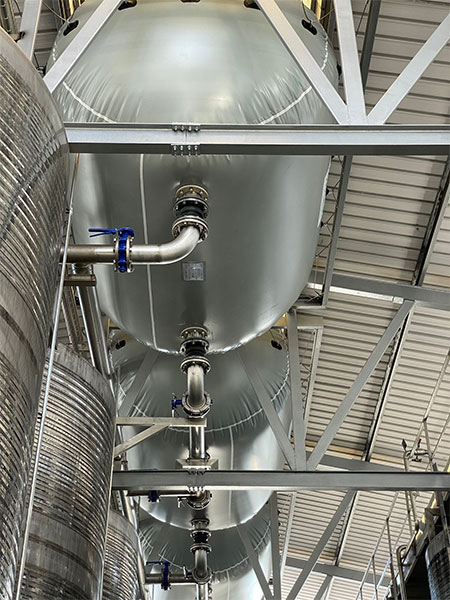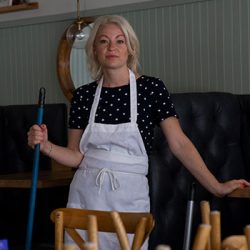The last time the earth’s atmosphere held as much CO2 as it does now—2.6 million years ago—trees were growing on the South Pole. Hoping to avoid that outcome, governments including the U.K and U.S. are exploring direct air capture (DAC) technologies. The goal is to diminish the concentration of CO2 in the planet’s atmosphere from 420 ppm down to 350 ppm.
Direct air capture is already at work in wineries, which have adopted DAC in order to trap gas from fermentation that would otherwise be released into the atmosphere. Bordeaux’s Château Montrose, in St-Estèphe, and Smith-Haut-Lafitte, in Pessac-Léognan, as well as Burgundy’s Domaine Dujac, in Morey-St-Denis, are looking to technologies that transform CO2, while Familia Torres, based in the Penedès region of Spain, has developed a system for carbon capture and reuse (CCR).
Torres captures CO2 in balloons positioned above their fermentation tanks; the CO2 is then compressed and stored until the team needs it to blanket and protect their wines in storage. Wineries often fill the headspace of their storage tanks with CO2 to protect the wine from oxidation; most purchase the inert gas from suppliers who usually acquire the gas from oil refineries. Fermentation CO2, on the other hand, is practically pure and considered emission neutral. Miguel A. Torres, president of Familia Torres, plans to share the technology with other wineries, noting through an email exchange that the family’s environmental program, started in 2008, has reduced CO2 emissions by 34 percent as of 2020. “Our goal for 2030 is to achieve a minimum of 60 percent C02 reduction,” he states, “with the intention of reaching even 70 percent, becoming a winery with zero net emissions before 2040.” Through International Wineries for Climate Action (IWCA), Torres and co-founder Katie Jackson, of Jackson Family Wines, have gathered 22 wineries committed to achieving carbon neutrality before 2050. “We cannot afford a ‘stand-by-and-watch’ attitude towards climate change anymore,” Torres says.


Josep Maria Ribas, Familia Torres’s Director of Climate Change, says that the team is still experimenting with its new carbon capture system. For now, the winery only uses the system for vertical tanks filled with must from white-wine grapes; red wine fermentations often involve open tanks or the introduction of oxygen into the must in closed tanks. Though limited, Ribas notes that the system has allowed the winery to reuse 20 tons of CO2 a year—a third of the gas that they would normally buy.
Roger Boulton, professor emeritus of enology at UC Davis, is pushing for more ambitious projects to capture CO2 fermentation emissions. He estimates that Torres is only capturing three to five percent of their CO2 emissions based on the size of a tank’s headspace and the amount of CO2 released from grape fermentation. While he thinks it’s a laudable small step, he believes that wineries need to come together to develop long-term solutions that capture all or most CO2 from fermentation emissions.
Boulton has been informally advising his former student, Diana Snowden Seysses, who has developed plans for a new winery at Domaine Dujac, to be completed in time for the 2022 harvest. The facility is designed to capture about 75 percent of the CO2 released during fermentation. “We have plumbed our tanks to move CO2 to a central location where it will be compressed,” Snowden-Seysses explained by email. “Our plan is to rent equipment from Alcion Environment in 2022 to turn our CO2 into bicarbonates. We’ll see how this method works out.” The method Dujac is implementing through Alcion is already in use by Smith-Haut-Lafitte and Montrose; both wineries store the bicarbonate in warehouses. Dujac plans to send their bicarbonate to Alcion’s parent company, Veolia, one of Europe’s largest waste management firms, who would then sell the bicarbonate to companies for biofuel conversion, with the resulting carbon being delivered to wineries for bicarbonate production. But, Snowden-Seysses notes that this idea is brand new and has never been implemented.
At Torres, Ribas acknowledges that bicarbonates can be a solution to trap CO2, but asks, “What do you do with them? Store the bicarbonate in a warehouse? If you give this bicarbonate to a third party, once it will be used, it will release the CO2 again.” While Torres’ new CCR solution is a relatively small reduction in their CO2 footprint, Ribas believes it’s a good start, and urges other wineries to do the same, citing economic and financial criteria as reasons companies decide whether or not to invest in CO2 reduction programs. “If you take those [criteria] as a starting point, sustainability programs are not very likely to be put in place.”
Both Snowden-Seysses and Ribas had considered the work of the Swiss company Climeworks, which pumps atmospheric CO2 deep into the ground for bicarbonate conversion. But Ribas found the system expensive, and Snowden-Seysses questioned the energy required to compress atmospheric CO2 from 420 ppm to 1 million ppm. CO2 from alcoholic fermentation, on the other hand, is already close to 1 million ppm. “That’s what makes alcoholic fermentations exciting. You’d save a lot of energy concentrating if you’re getting it off a tank of fermenting sugar,” Snowden-Seysses explained in a phone call.
Snowden-Seysses’ preferred scenario would be to establish a network of pipes underneath viticultural areas that could deliver fermentation CO2 emissions to one central location, where the job year-round is to take concentrated CO2 and turn it into biofuel. “Two hundred years ago, in Europe, people just threw their sewage out the door […] and now there’s plumbing that takes it somewhere…I don’t see why the same can’t happen with compressed CO2 going to one central place.” She emphasizes that her adoption of Alcion’s method is a trial with a technology that changes day by day: “In the last month, I’ve received three new and different CO2 scrubbing methods in my inbox.”
David lives in New York City and is always looking for the next wine story worth sharing.
This is a W&S web exclusive. Get access to all of our feature stories by signing up today.

















